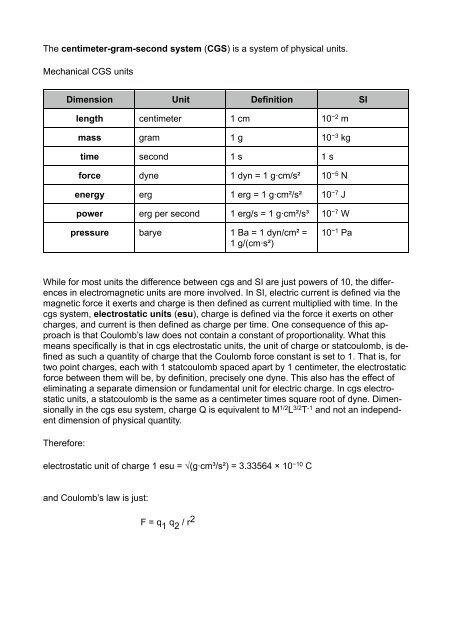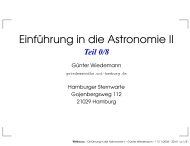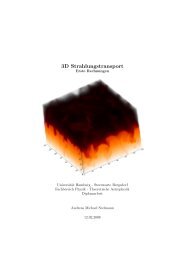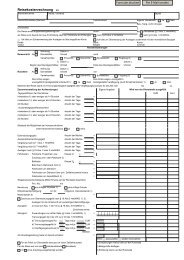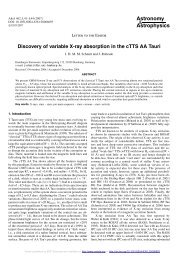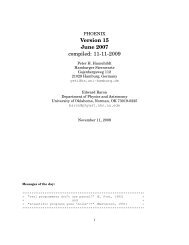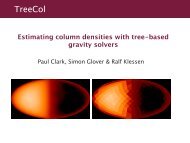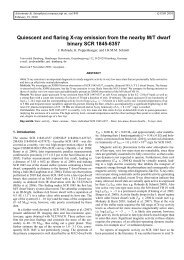The centimeter-gram-second system - faculty.jacobs-university.de
The centimeter-gram-second system - faculty.jacobs-university.de
The centimeter-gram-second system - faculty.jacobs-university.de
You also want an ePaper? Increase the reach of your titles
YUMPU automatically turns print PDFs into web optimized ePapers that Google loves.
<strong>The</strong> <strong>centimeter</strong>-<strong>gram</strong>-<strong>second</strong> <strong>system</strong> (CGS) is a <strong>system</strong> of physical units.<br />
Mechanical CGS units<br />
Dimension Unit Definition SI<br />
length <strong>centimeter</strong> 1 cm 10 −2 m<br />
mass <strong>gram</strong> 1 g 10 −3 kg<br />
time <strong>second</strong> 1 s 1 s<br />
force dyne 1 dyn = 1 g·cm/s² 10 −5 N<br />
energy erg 1 erg = 1 g·cm²/s² 10 −7 J<br />
power erg per <strong>second</strong> 1 erg/s = 1 g·cm²/s³ 10 −7 W<br />
pressure barye 1 Ba = 1 dyn/cm² =<br />
1 g/(cm·s²)<br />
10 −1 Pa<br />
While for most units the difference between cgs and SI are just powers of 10, the differences<br />
in electromagnetic units are more involved. In SI, electric current is <strong>de</strong>fined via the<br />
magnetic force it exerts and charge is then <strong>de</strong>fined as current multiplied with time. In the<br />
cgs <strong>system</strong>, electrostatic units (esu), charge is <strong>de</strong>fined via the force it exerts on other<br />
charges, and current is then <strong>de</strong>fined as charge per time. One consequence of this approach<br />
is that Coulomb’s law does not contain a constant of proportionality. What this<br />
means specifically is that in cgs electrostatic units, the unit of charge or statcoulomb, is <strong>de</strong>fined<br />
as such a quantity of charge that the Coulomb force constant is set to 1. That is, for<br />
two point charges, each with 1 statcoulomb spaced apart by 1 <strong>centimeter</strong>, the electrostatic<br />
force between them will be, by <strong>de</strong>finition, precisely one dyne. This also has the effect of<br />
eliminating a separate dimension or fundamental unit for electric charge. In cgs electrostatic<br />
units, a statcoulomb is the same as a <strong>centimeter</strong> times square root of dyne. Dimensionally<br />
in the cgs esu <strong>system</strong>, charge Q is equivalent to M 1/2 L 3/2 T -1 and not an in<strong>de</strong>pen<strong>de</strong>nt<br />
dimension of physical quantity.<br />
<strong>The</strong>refore:<br />
electrostatic unit of charge 1 esu = √(g·cm³/s²) = 3.33564 × 10 −10 C<br />
and Coulomb’s law is just:<br />
F = q 1 q 2 / r 2
ASTRONOMICAL CONSTANTS AND CONVERSION FACTORS<br />
SI VALUE CGS VALUE<br />
Mass of sun (M u ) 1.989x1030 kg 1.989x10 33 g<br />
Radius of sun (R u ) 6.959x108 m 6.959x10 10 cm<br />
Luminosity of sun (L u ) 3.826x1026 W 3.826x10 33 erg s -1<br />
Mass of earth (M r ) 5.976x1024 kg 5.976x10 27 g<br />
Equatorial Radius of earth (R r ) 6.378x106 m 6.378x10 8 cm<br />
Astronomical unit (au) 1.496x10 11 m 1.496x10 13 cm<br />
Parsec (pc) 3.086x10 16 m 3.086x10 18 cm<br />
Tropical year 3.156x10 7 s 3.156x10 7 s<br />
PLANETARY DATA<br />
Planet Semi-Major Axis Si<strong>de</strong>real Period Orbital M/M¾ R/R¾<br />
(au) (tropical yrs) Eccentricity<br />
Mercury .3871 .24085 .2056 0.0558 0.382<br />
Venus .7233 .61521 .0068 0.8150 0.949<br />
Earth 1.000 1.000039 .0167 1.0000 1.000<br />
Mars 1.5237 1.88089 .0934 0.1074 0.532<br />
Jupiter 5.2028 11.8622 .0483 317.893 11.27<br />
Saturn 9.538 29.4577 .0560 94.147 9.44<br />
Uranus 19.191 84.013 .0461 14.54 4.10<br />
Neptune 30.061 164.793 .0097 17.23 3.88<br />
Pluto 39.529 248.54 .2482 .0022 0.180<br />
SOLAR DATA<br />
Apparent bolometric magnitu<strong>de</strong>, m bol: -26.82<br />
Apparent visual magnitu<strong>de</strong>, m V (or V): -26.74<br />
Absolute bolometric magnitu<strong>de</strong>, M bol: + 4.75<br />
B - V colour in<strong>de</strong>x: + 0.65<br />
Spectral Type and Luminosity Class: G2 V<br />
Effective Temperature (T eff): 5770 °K<br />
MISCELLANEOUS<br />
Hubble's Constant: 75 km s -1 Mpc -1
ASTRONOMY DATA SHEET<br />
UNITS<br />
Physical Quantity SI Unit CGS Value<br />
Mass 1 kg 10 3 g<br />
Length 1 m 10 2 cm<br />
Time 1 s 1 s<br />
Energy 1 joule (J) 10 7 erg<br />
Power 1 watt (W) 10 7 erg s -1<br />
Force 1 newton (N) 10 5 dyne<br />
Velocity 1 m s -1 10 2 cm s -1<br />
Pressure 1 pascal (Pa) 10 dyn cm -2<br />
Density 1 kg m -3 10 -3 g cm -3<br />
Electric Charge 1 Coulomb (C) 2.998x10 9 esu<br />
Magnetic flux <strong>de</strong>nsity 1 Tesla (T) 10 4 gauss<br />
PHYSICAL CONSTANTS AND CONVERSION FACTORS<br />
SI Value CGS Value<br />
Speed of light, c: 2.998x10 8 m s -1 2.998x10 10 cm s -1<br />
Gravitational constant, G: 6.670x10 -11 N m 2 kg -2 6.670x10 -8 dyn cm 2 g -2<br />
Planck constant, h: 6.626x10 -34 J s 6.626x10 -27 erg s<br />
Boltzmann constant, k: 1.381x10 -23 J K -1 1.381x10 -16 erg K -1<br />
Electric charge, e: 1.602x10 -19 C 4.803x10 -10 esu<br />
Stefan Boltzmann constant, F: 5.669x10 -8 W m -2 K -4 5.669x10 -5 erg cm -2 K -4 s -1<br />
Radiation <strong>de</strong>nsity constant, a: 7.565x10 -16 J m -3 K -4 7.565x10 -15 erg cm -3 K -4<br />
Mass of electron 9.1096x10 -31 kg 9.1096x10 -28 g<br />
Mass of proton 1.6726x10 -27 kg 1.6726x10 -24 g<br />
Mass of neutron 1.6749x10 -27 kg 1.6749x10 -24 g<br />
Mass of hydrogen atom 1.6735x10 -27 kg 1.6735x10 -24 g<br />
Mass of helium atom 6.6464x10 -27 kg 6.6464x10 -24 g<br />
1 amu 1.66053x10 -27 kg 1.66053x10 -24 g<br />
1 ev 1.602x10 -19 J 1.602x10 -12 erg<br />
1 A 10 -10 m 10 -8 cm<br />
Wien's law constant 2.898x10 -3 m K 0.2898 cm K


